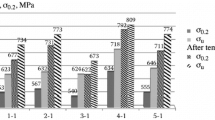Conclusions
-
1.
Heat treatment of bimetals with a cladding layer of steel Kh18N10T and holding at elevated temperature lead to diffusion of carbon into the cladding layer, the effect increasing with less alloying of the base metal.
-
2.
The carburized zone in the two-layer steel induced by carbon diffusion lowers the ductility, which must be taken into account in welding, heat treatment, and operation of apparatus manufactured from two-layer steels.
Similar content being viewed by others
Literature cited
S. A. Golovanenko, S. B. Maslenkov, and I. Yu. Konnova, “Low-temperature diffusion in bimetals in the process of prolonged isothermal annealing“, in: Diffusion in Metals and Alloys [in Russian], Tula (1968), p. 401.
S. A. Golovanenko, S. B. Maslenkov, and I. Yu. Konnova, “Structure and properties of boundary zone in bimetals St3+0Kh13 and St3+Kh18N9T“, in: Transactions of the Central Scientific-Research Institute of Ferrous Metallurgy [in Russian], No. 52 (1967), p. 58.
K. E. Charukhina et al., Bimetallic Compounds [in Russian], Metallurgiya, Moscow (1970).
S. A. Golovanenko and A. P. Surovtsev, “Effect of carbon redistribution on properties of corrosion resistant bimetals“, Byulleten' Inst, Chermetinformatsiya, No. 16, 55 (1972).
N. P. Chernykh, V. I. Arsen'ev, and A. P. Korchagin, “Hydrogen corrosion and hydrogen permeability of two-layer steels“, Zashchita Metal.,6, No. 5, 593 (1970).
B. I. Shevelkin, “Promising two-layer metals for machine construction“, in: Two-Layer Steels in Machine Construction [in Russian], Trudov NIIKhIMMASh, No. 53 (1967), p. 3.
L. G. Gokhshtein, É. A. Savchenkov, and A. A. Yavor, “Diffusion of carbon in multilayer steels and its effect on mechanical properties“, in: Metal Science and Strength of Materials [in Russian], Tula (1968), p. 355.
S. A. Golovanenko, “Selecting systems of alloying for steels used as the base metal in corrosion resistant bimetals“, Metal. i Term. Obrabotka Metal., No. 1, 47 (1971).
Additional information
Irkutsk Scientific-Research Institute of Chemical Machine Construction. Translated from Metallovedenie i Termicheskaya Obrabotka Metallov, No. 11, pp. 25–27, November, 1975.
Rights and permissions
About this article
Cite this article
Chernykh, N.P., Arsen'ev, V.I., Turitsina, A.P. et al. Effect of carbon diffusion during tempering and heating in operation on the mechanical properties of two-layer steels. Met Sci Heat Treat 17, 930–932 (1975). https://doi.org/10.1007/BF00679381
Issue Date:
DOI: https://doi.org/10.1007/BF00679381




